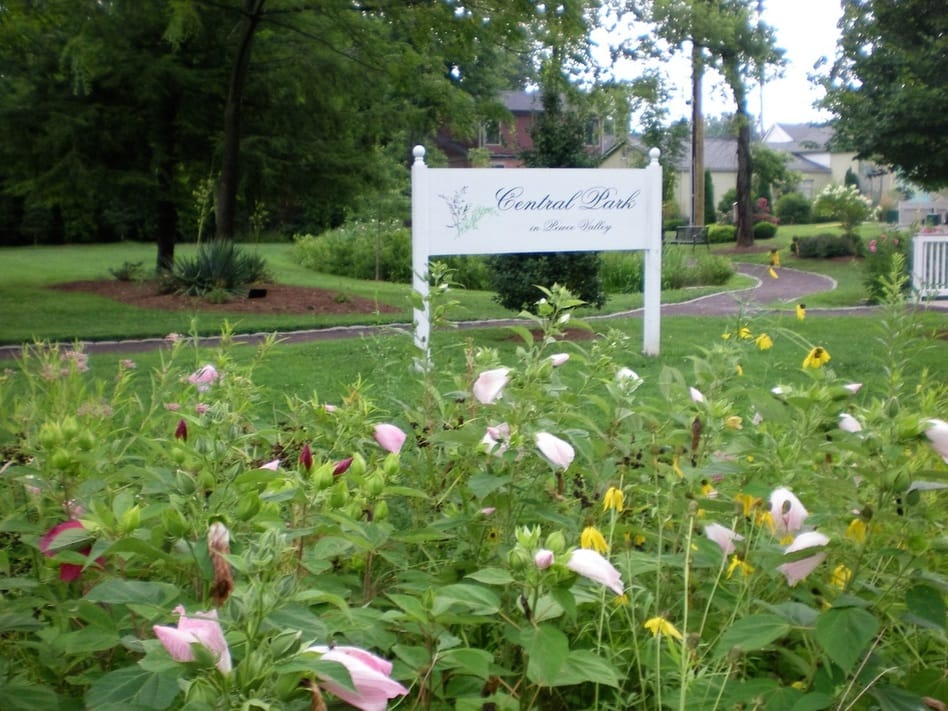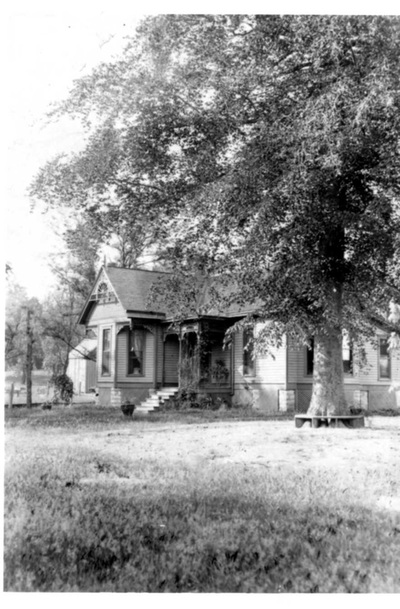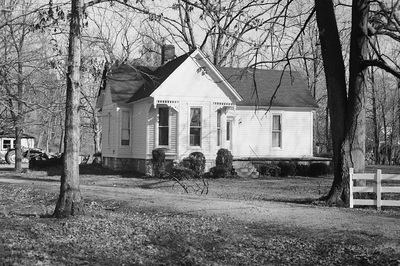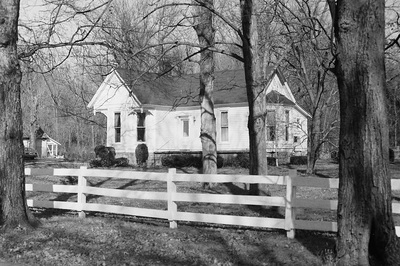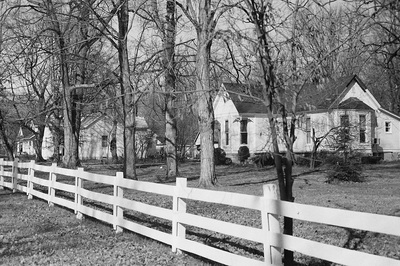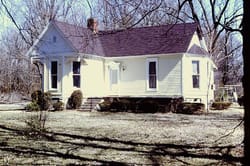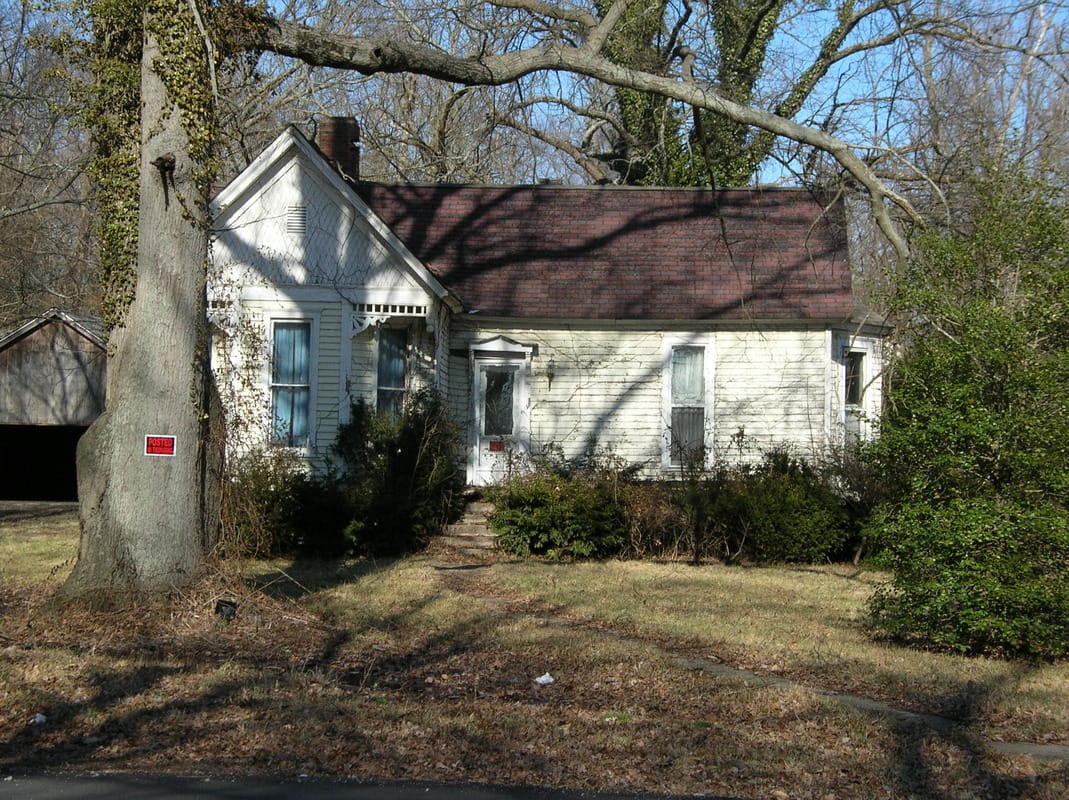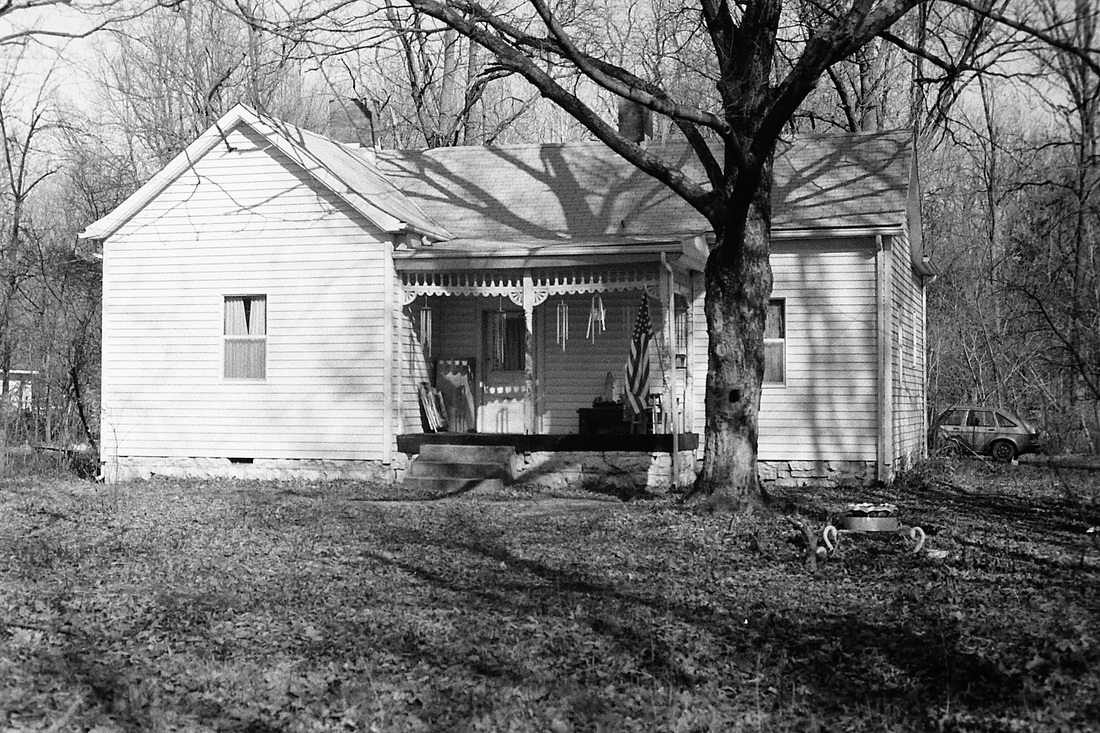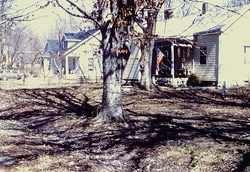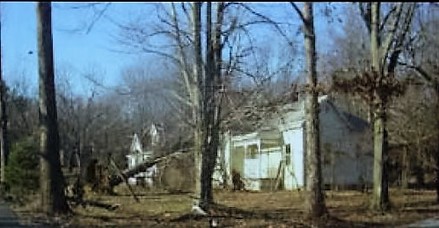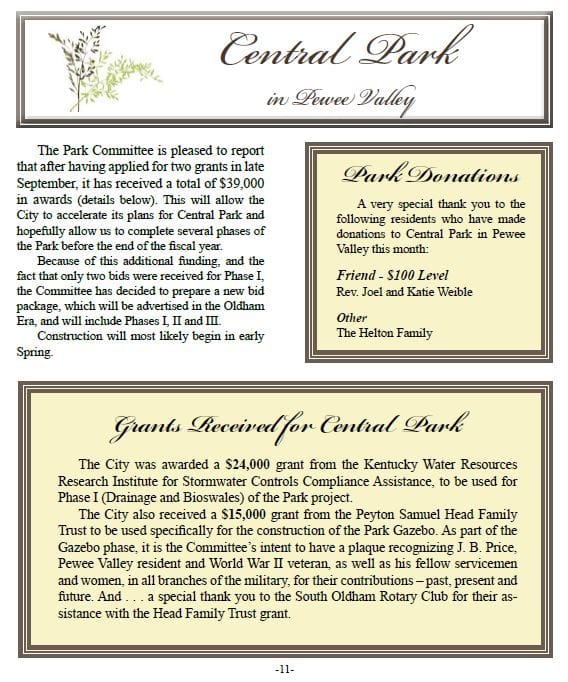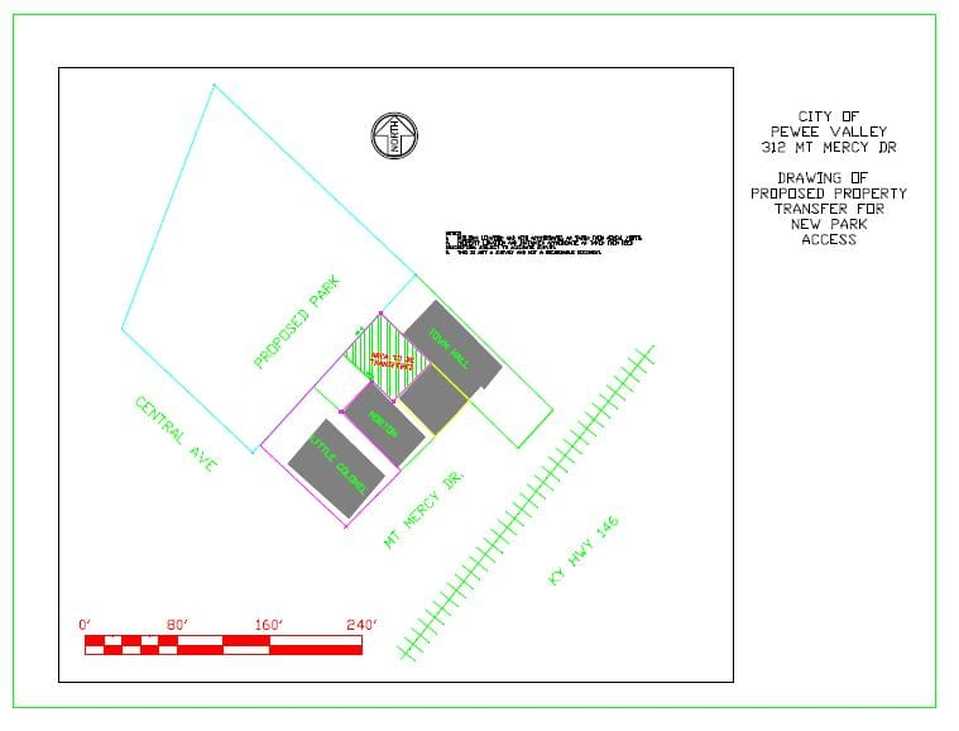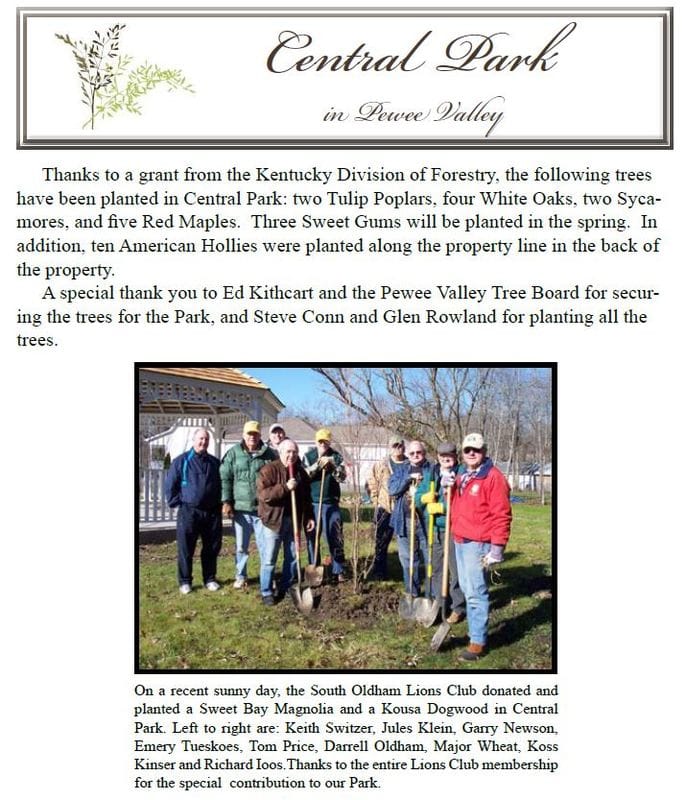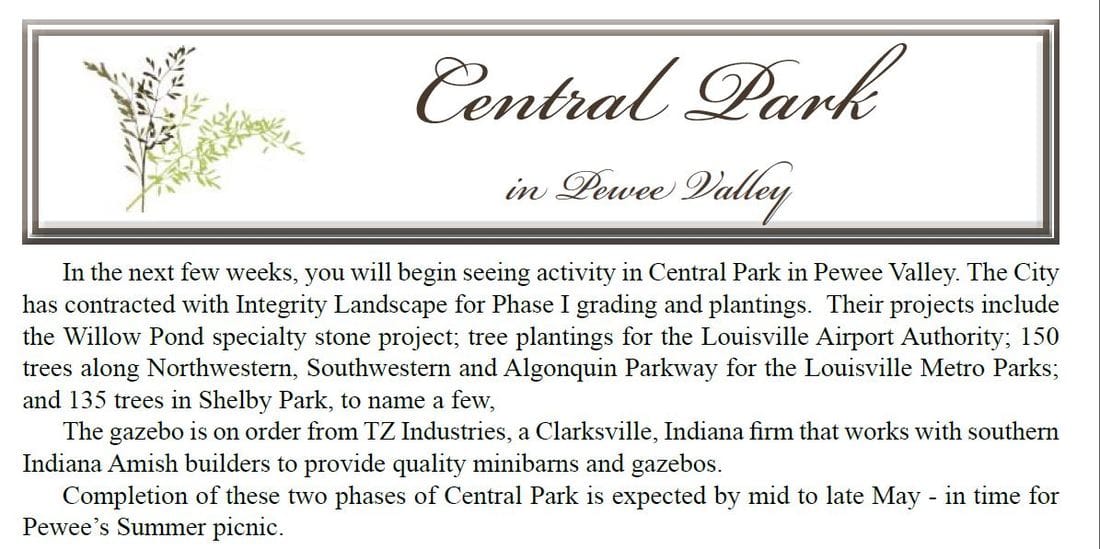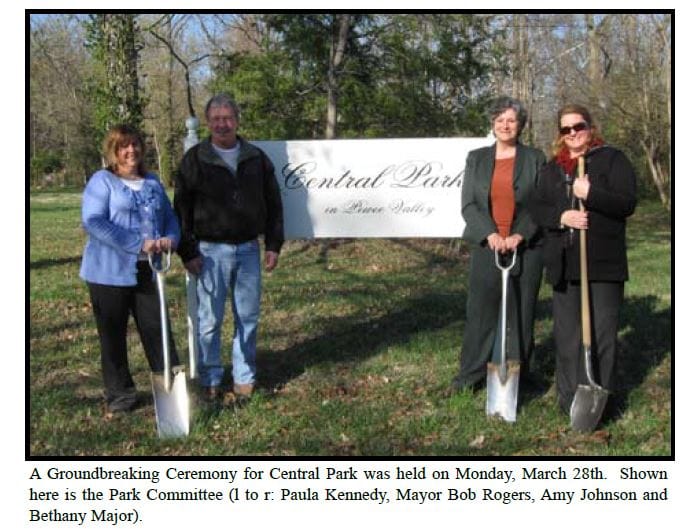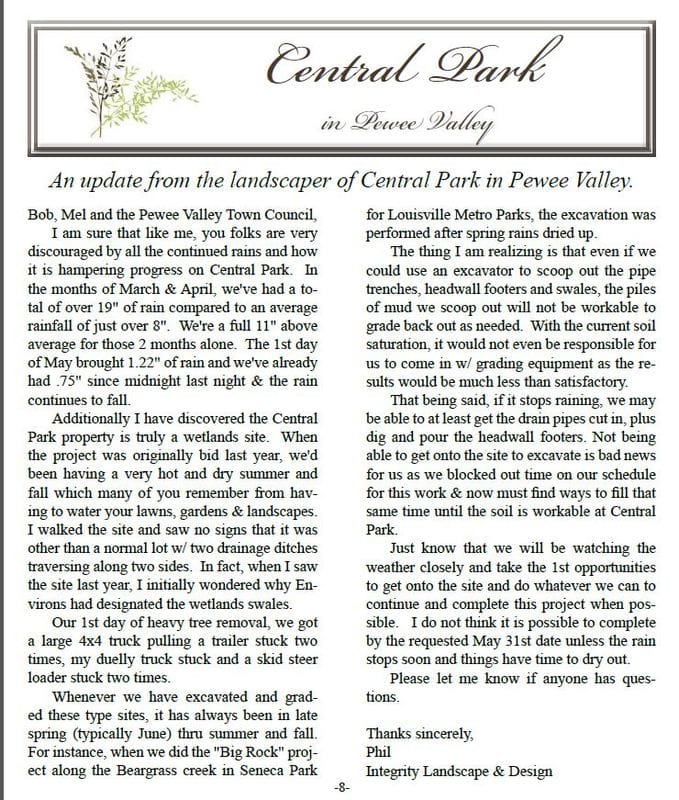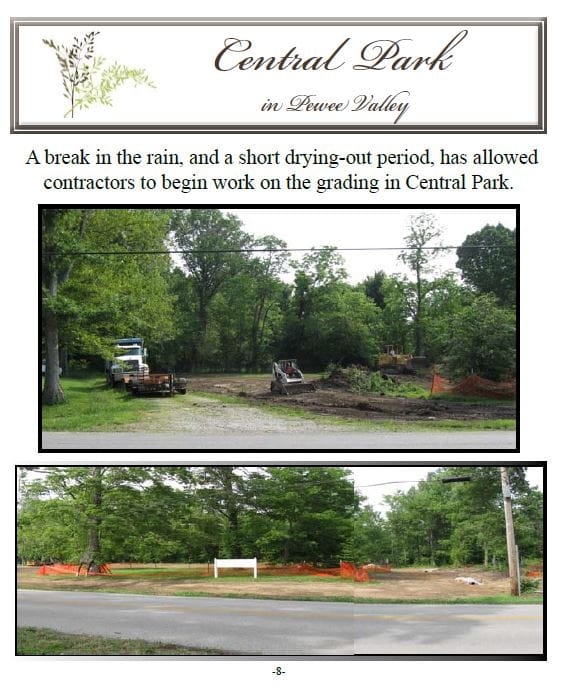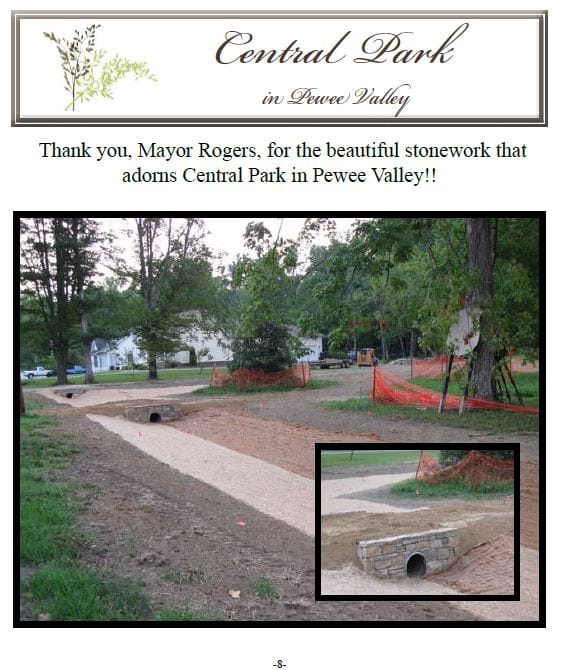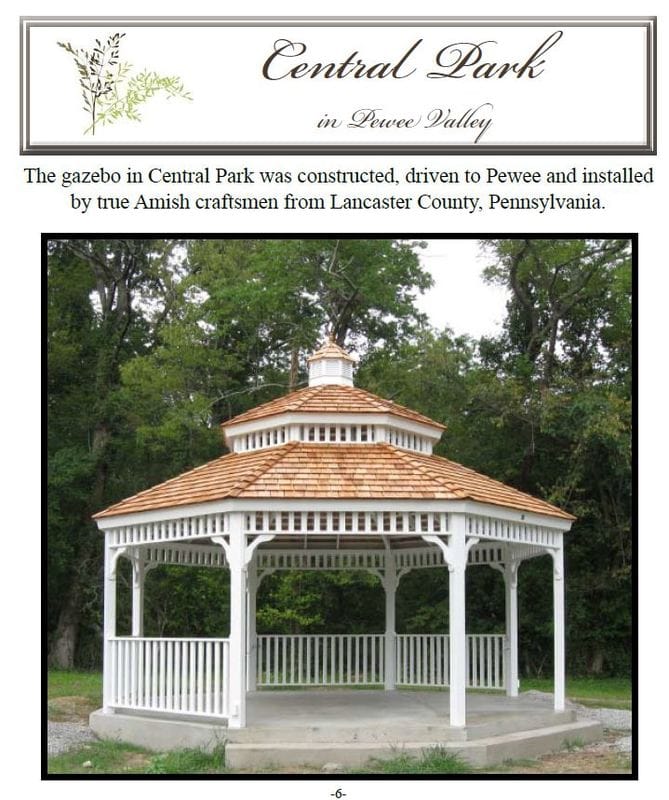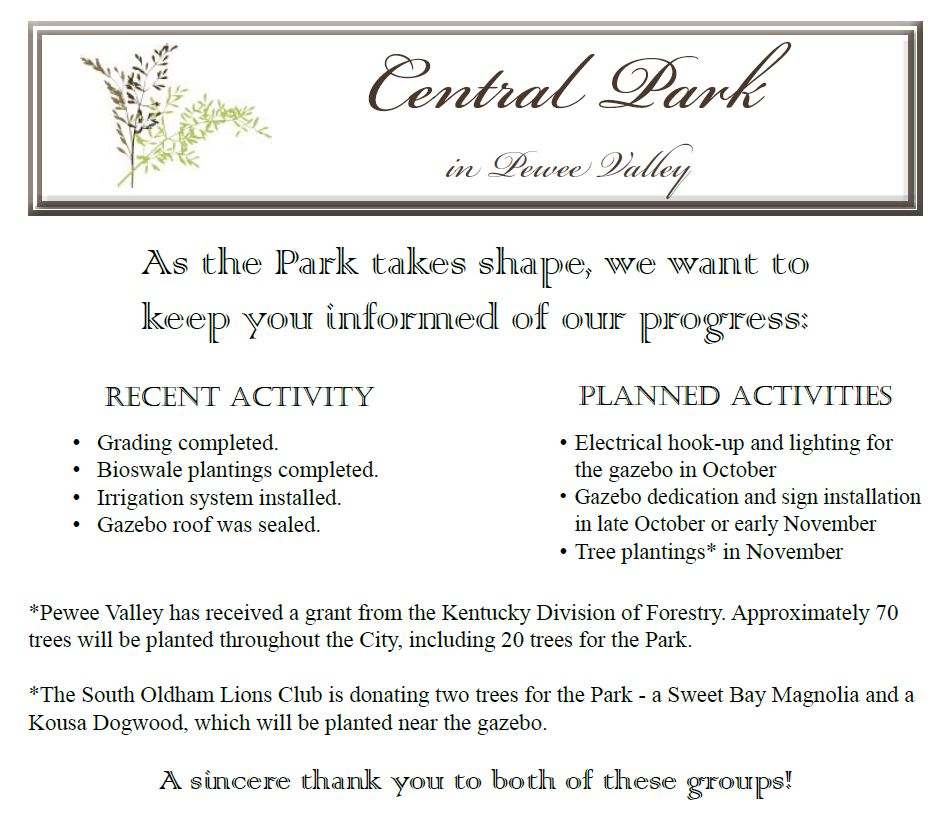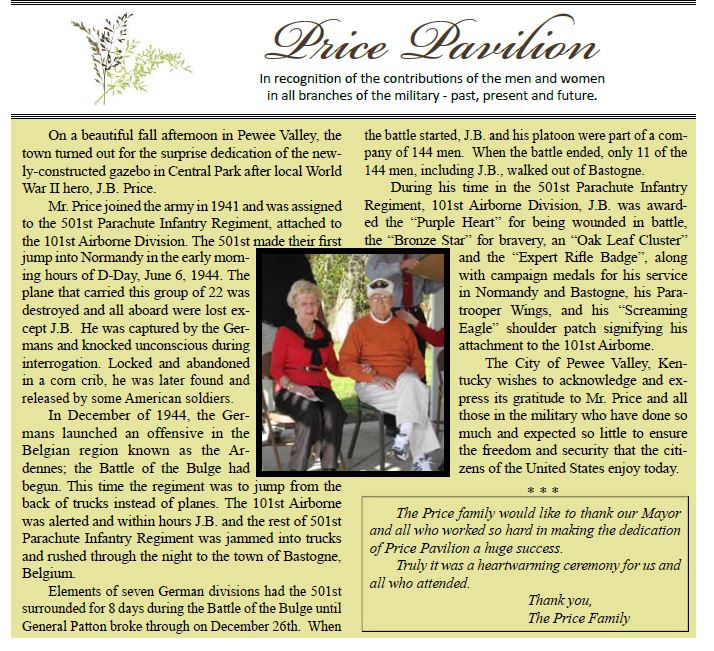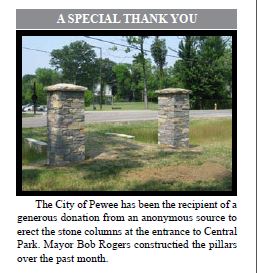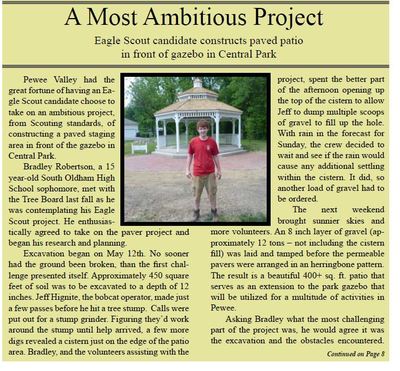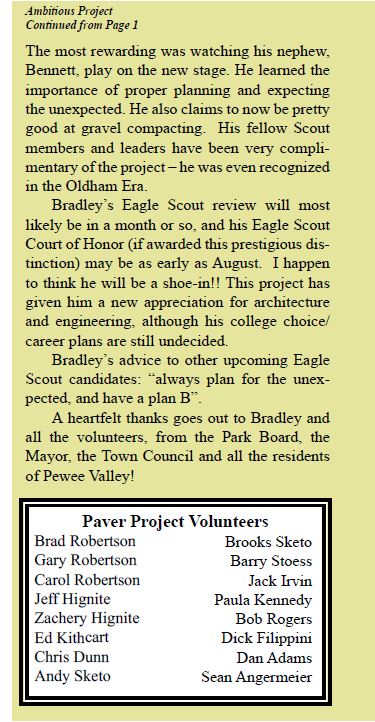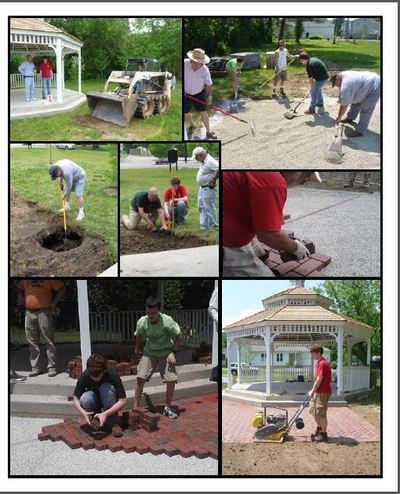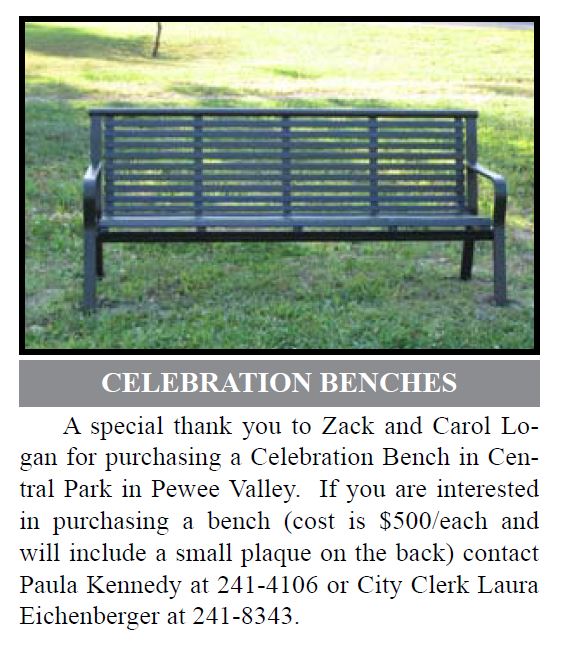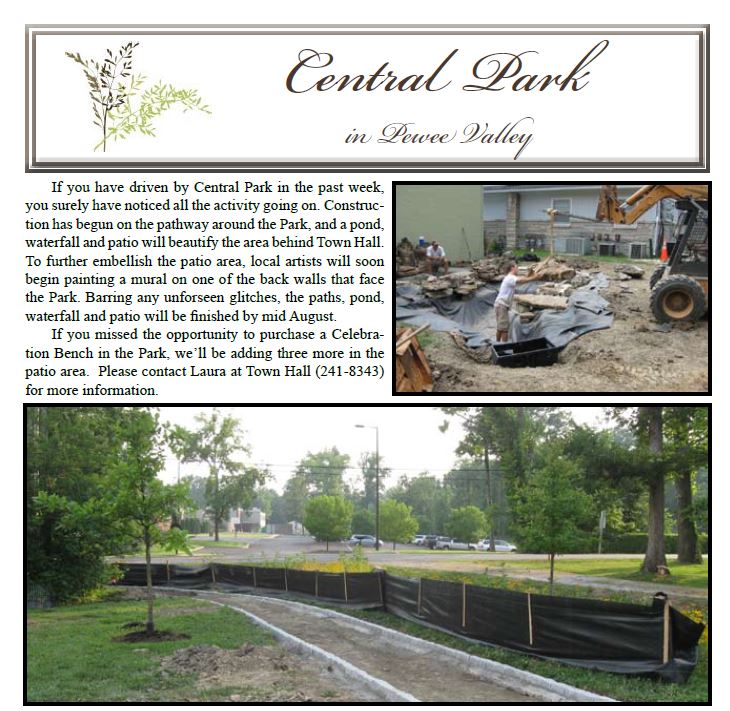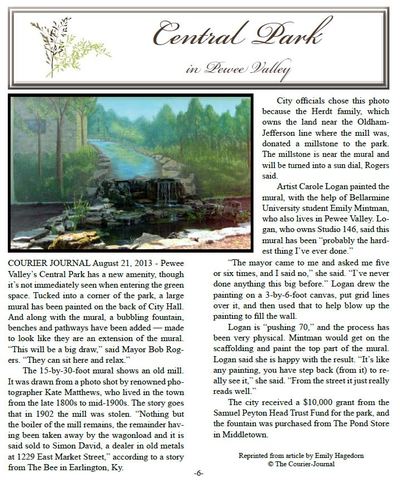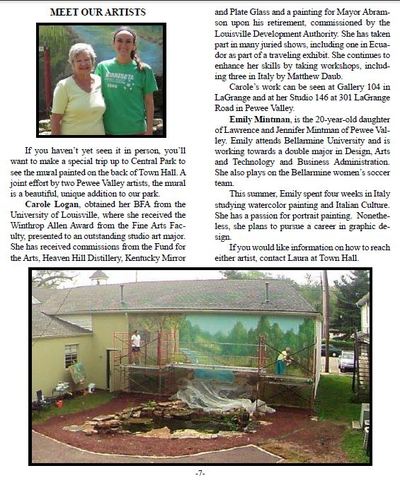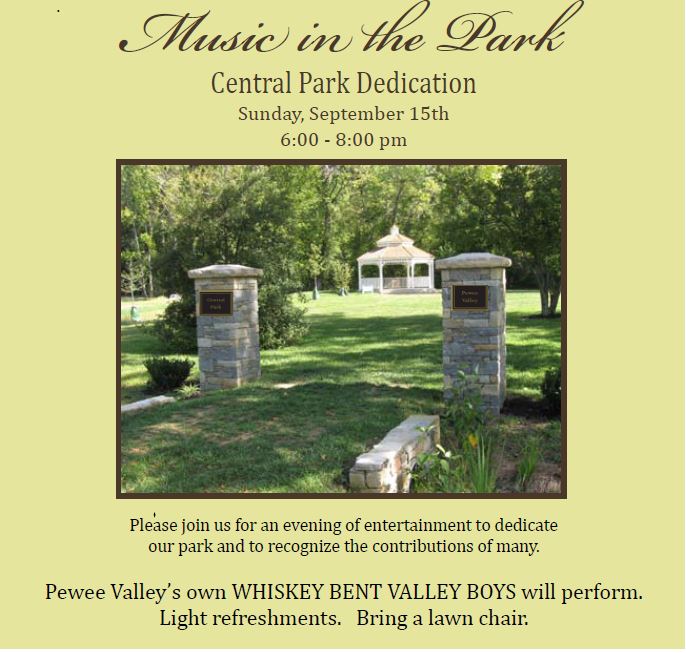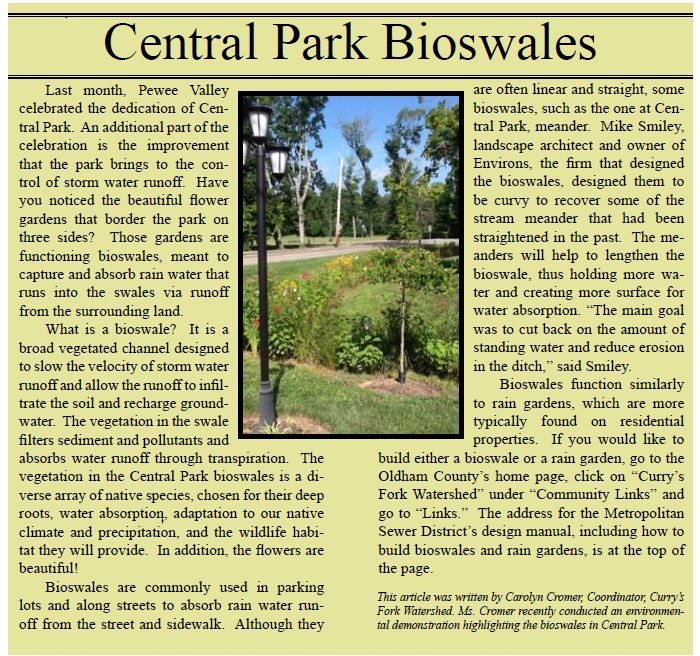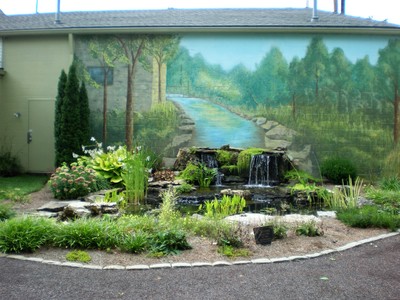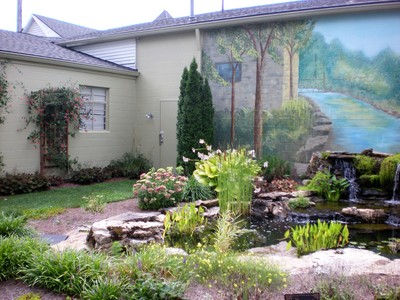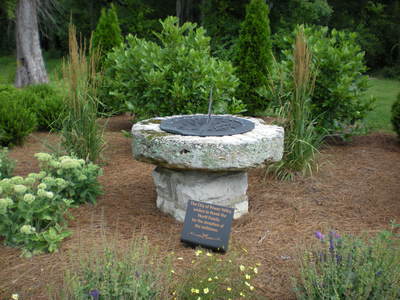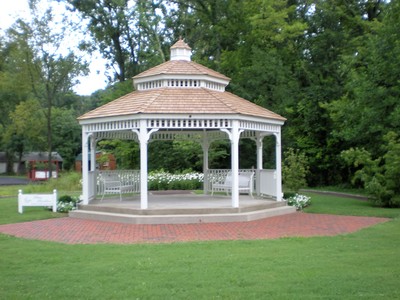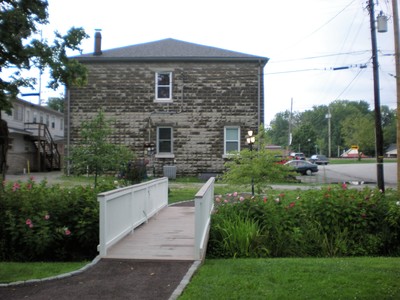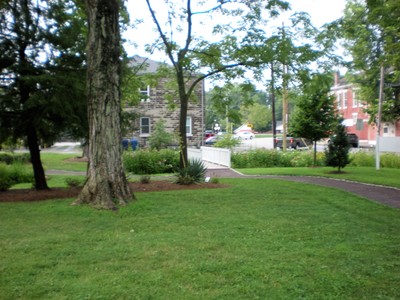Central Park
B.C. -- Before Central Park
The land on which Central Park now stands was once privately owned. According to a Valley Vignette by Iris Haskins in the February 1977 Call of the Pewee, a circuit judge at one time used the lot in the summertime to try cases:
...Mary G. Johnston told me this incident that happened in her day:
A familiar sight in Pewee Valley was old Judge Estill with his big black umbrella. In the winter he carried it over him to keep off the wind, rain and snow and in the summer he would carry it to keep off the sun. He was the Circuit Judge, and when he held court in the summer he held it in back of the General Mercantile Store (now the home of the Little Colonel Players) under the trees. There was a Pewee fence around the back yard of the store, and he would put a chair on a soap box, fasten his umbrella to the back of the chair, and sit up there in state and conduct court. The jury sat on the fence. When it was time to make a decision, those who voted positive got off on the inside of the fence, and those who voted negative got off on the outside. Many friends and enemies were made according to which side of the fence you were on. (Editor's note: This appears to be a "suburban" legend. Benjamin Estill (1780-1853) moved to Pewee Valley from Virginia in 1852, where he had served first as a U.S. Congressman and then for many years on the Judicial Circuit Court. He died a year after moving here. The original store that stood on the spot where the Little Colonel Playhouse now stands wasn't built until 1889. In addition, Mary Johnston wasn't born until 1872. Was this tale actually about one of Pewee Valley's early town marshals? Perhaps, but none by the name Estes or Estill has been found.)
A Victorian vernacular cottage was built on the property around 1895, probably by John M. McFarland, according to the 1981 Kentucky Historic Resources Inventory. Over the years, the house changed hands many times, and was owned at various times by the Clelands, the Tschiffleys, Tom Murphy and others. Along the way, it lost its porch and some of its Victorian bric-a-brac, possibly in a 1980 fire. The September 1980 Call of the Pewee reported:
...Mary G. Johnston told me this incident that happened in her day:
A familiar sight in Pewee Valley was old Judge Estill with his big black umbrella. In the winter he carried it over him to keep off the wind, rain and snow and in the summer he would carry it to keep off the sun. He was the Circuit Judge, and when he held court in the summer he held it in back of the General Mercantile Store (now the home of the Little Colonel Players) under the trees. There was a Pewee fence around the back yard of the store, and he would put a chair on a soap box, fasten his umbrella to the back of the chair, and sit up there in state and conduct court. The jury sat on the fence. When it was time to make a decision, those who voted positive got off on the inside of the fence, and those who voted negative got off on the outside. Many friends and enemies were made according to which side of the fence you were on. (Editor's note: This appears to be a "suburban" legend. Benjamin Estill (1780-1853) moved to Pewee Valley from Virginia in 1852, where he had served first as a U.S. Congressman and then for many years on the Judicial Circuit Court. He died a year after moving here. The original store that stood on the spot where the Little Colonel Playhouse now stands wasn't built until 1889. In addition, Mary Johnston wasn't born until 1872. Was this tale actually about one of Pewee Valley's early town marshals? Perhaps, but none by the name Estes or Estill has been found.)
A Victorian vernacular cottage was built on the property around 1895, probably by John M. McFarland, according to the 1981 Kentucky Historic Resources Inventory. Over the years, the house changed hands many times, and was owned at various times by the Clelands, the Tschiffleys, Tom Murphy and others. Along the way, it lost its porch and some of its Victorian bric-a-brac, possibly in a 1980 fire. The September 1980 Call of the Pewee reported:
Joe Gootee, who retired as the Pewee Valley barber a few years ago because of ill health, and his family were made homeless Saturday, August 23, when fire badly damaged their home at 105 Central Avenue. Everyone was asleep when the blaze started early Saturday morning, but all escaped unharmed although Joe is a wheelchair invalid.
There was a report that a flammable substance had been thrown into the house and ignited, and as a result an investigator from the State Fire Marshal's office is looking into the possibility of arson...
There was a report that a flammable substance had been thrown into the house and ignited, and as a result an investigator from the State Fire Marshal's office is looking into the possibility of arson...
The Morris Property at 105 Central Avenue ca. the 1920s and in 1989
By 2006, the property was up for sale at the Oldham County Courthouse. Owner Jerry Lee Morris, a real estate agent, had died there on February 15, 2005. Back taxes were owed. At the time, Peweeans were reeling from St. Aloysius Catholic Church's plan to turn Woodside into a sports field, permanently changing the character of the city's Central Avenue Historic District by clear-cutting the heavily treed lot. Fearful of what might become of the Morris property, in January 2007, during an Executive Session, City Council authorized Mayor Clayton Stoess, on a 4-1 vote, to spend up to $150,000 to purchase it for possible use as a museum.
There were two compelling reasons to save the cottage. First, the Morris property and the cottage beside it were considered contributing structures in the National Register nomination for the Central Avenue Historic District, and the Morris house in particular was one of the only surviving examples of Victorian vernacular cottages in Pewee Valley.
Second, author Annie Fellows Johnston had used the cottage as the setting for one of the scenes in her 1905 novel, The Little Colonel's Christmas Vacation. The home of Mrs. Bisbee with the "Window in Thrums" was in real life the home of Mrs. Louise Cleland, a former teacher at the Kentucky College for Young Ladies and the widow of the Rev. T.H. Cleland, who at one time had pastored the Pewee Valley Presbyterian Church. She purchased the house from the McFarlands in 1900 and owned it until 1909:
Lloyd hurried down the road to the post-office ... She wished that Miss Mattie would invite her into the tiny office behind the rows of pigeonholes and letter-boxes, and let her sit by the window awhile. Just watching people pass would be some amusement, more than she could find at home.
She was passing the Bisbee place as she made the wish. It was a white frame house standing near the road, and commanding a view of both station and store, as well as the approach to the post-office. To her surprise, some one tapped on the pane of an up-stairs window. Then the sash flew up, and Mrs. Bisbee called in her thin, fluttering voice: "Lloyd! Lloyd Sherman! If you're going to the post-office, I wish you'd ask if there is anything for me. I don't dare set foot out-of-doors this cold weather."
Then, fearful of draughts, she banged the window down without waiting for a reply. Lloyd smiled and nodded, glad of an opportunity to be of service. As she hurried on, she remembered that Miss Allison had spoken of this gentle little old lady, with her fluttering voice and placid smile, as one of the most interesting and "Cranfordy" characters in the Valley, and that, while she never went out in the winter, and seldom in the summer, except to church, she kept such a sharp eye on the neighbourhood happenings from the watch-tower of her window that Mrs. Walton laughingly called it the "Window in Thrums."
Second, author Annie Fellows Johnston had used the cottage as the setting for one of the scenes in her 1905 novel, The Little Colonel's Christmas Vacation. The home of Mrs. Bisbee with the "Window in Thrums" was in real life the home of Mrs. Louise Cleland, a former teacher at the Kentucky College for Young Ladies and the widow of the Rev. T.H. Cleland, who at one time had pastored the Pewee Valley Presbyterian Church. She purchased the house from the McFarlands in 1900 and owned it until 1909:
Lloyd hurried down the road to the post-office ... She wished that Miss Mattie would invite her into the tiny office behind the rows of pigeonholes and letter-boxes, and let her sit by the window awhile. Just watching people pass would be some amusement, more than she could find at home.
She was passing the Bisbee place as she made the wish. It was a white frame house standing near the road, and commanding a view of both station and store, as well as the approach to the post-office. To her surprise, some one tapped on the pane of an up-stairs window. Then the sash flew up, and Mrs. Bisbee called in her thin, fluttering voice: "Lloyd! Lloyd Sherman! If you're going to the post-office, I wish you'd ask if there is anything for me. I don't dare set foot out-of-doors this cold weather."
Then, fearful of draughts, she banged the window down without waiting for a reply. Lloyd smiled and nodded, glad of an opportunity to be of service. As she hurried on, she remembered that Miss Allison had spoken of this gentle little old lady, with her fluttering voice and placid smile, as one of the most interesting and "Cranfordy" characters in the Valley, and that, while she never went out in the winter, and seldom in the summer, except to church, she kept such a sharp eye on the neighbourhood happenings from the watch-tower of her window that Mrs. Walton laughingly called it the "Window in Thrums."
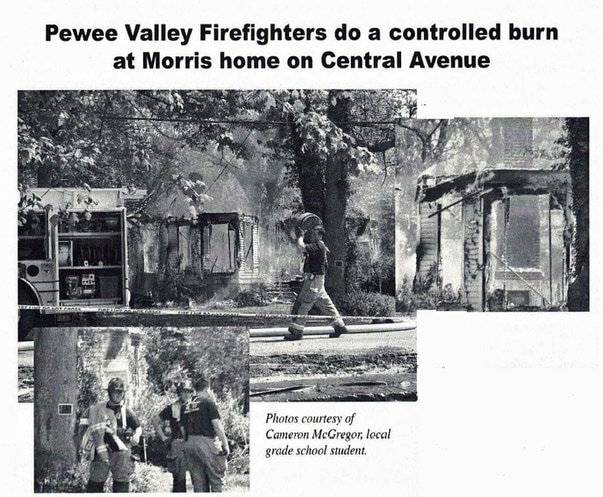 June 2007 Call of the Pewee
June 2007 Call of the Pewee
After the purchase, however, an inspection conducted by Peweean and home builder Ellery Esposito revealed "... several serious structural issues..., including a displaced foundation, sinking, and water infiltration under the crawl space. Due to the fragile condition of the building, he recommended that it be demolished, calling it a potential liability for the city," reported the April 2007 Call of the Pewee. "...the City has two choices...: demolish the house for potential park/green space usage or try to repair the house..."
With few grant opportunities available to pay for the restoration, the Council voted unanimously for demolition, and the Pewee Valley Fire Department burned the cottage down on Saturday, May 12, 2007.
With few grant opportunities available to pay for the restoration, the Council voted unanimously for demolition, and the Pewee Valley Fire Department burned the cottage down on Saturday, May 12, 2007.
|
Some residents expressed their displeasure at the way the city had handled the purchase of the Morris property at a City Council meeting later that year. The September Call of the Pewee reported: Resident George Farmer asked if he could share a few comparisons of the city’s purchase of the Morris property and the recent sale of ... (109 Central Avenue). There was no title search or survey done on the Morris property, yet both were done for the private property. Property taxes were in arrears on the Morris property, but up-to-date on the private property. The Morris house was not habitable, and the private property was habitable up until the time when a tree fell on it. The Morris property has a private road that runs through it and the private property does not. (Editor's note: this was one of the old driveways to the former Kentucky Confederate Home property.) The Morris property was purchased for approximately $150,000 plus back taxes, and the private property was purchased for $55,000. Mr. Farmer asked if this was an example of an individual being more financially savvy than our government. |
The city then began exploring grants to build a park and amphitheater on the site for use by the city as well as the Little Colonel Playhouse.
Before the city had the time to develop a comprehensive plan for the Morris property, Mother Nature destroyed the house next door. The evening of January 29, 2008, 85-mile-per-hour straight line winds struck Pewee Valley, damaging the Little Colonel Playhouse and knocking down dozens of trees. Heavily damaged when a large tree in the front yard was toppled, the cottage at 109 Central Avenue had to be demolished. Later, a new house with a Victorian feel was built on the site. |
Creating Central Park
Some four years elapsed from the purchase of the Morris property to finishing the park, because the City relied heavily on grants, donations and volunteer labor to bring the project to fruition. Landmarks in the park's development were chronicled by the Call of the Pewee.
August 2010 Call of the Pewee: Peweeans are asked to vote on the new park's name

October 2010 Call of the Pewee: The City of Pewee Valley is awarded two large grants to help fund the park
November 2010 Call of the Pewee: Norton Healthcare donates land to the City for Central Park
December 2010 Call of the Pewee: The City of Pewee Valley receives grants from the Kentucky Division of Forestry and South Oldham Lions Club for tree plantings
March 2011 Call of the Pewee: Bids are received for the first two phases of construction
April 2011 Call of the Pewee: Ground is officially broken on March 28, 2011
May 2011 Call of the Pewee: Wet weather hampers construction plans
June 2011 Call of the Pewee: Grading begins
July 2011 Call of the Pewee: Initial stonework is completed and paths are graded
August 2011 Call of the Pewee: Gazebo Installation
September 2011 Call of the Pewee: Progress report
November 2011: Dedication of Price Pavillion
May 2012: Stone Pillars at Entry and Paving Around Price Pavillion
August 2012: Celebration Benches
July 2013: Water Feature and Walking Paths
August 2013: Mural By Artist Carole Logan and Emily Mintman
September 15, 2013: Dedication
September 2013: The Role of the Bioswales
Central Park Today: Photos Taken July 2016 by Donna Russell
Related Links

